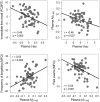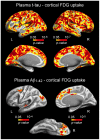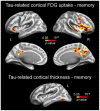Plasma tau predicts cerebral vulnerability in aging
- PMID: 33147571
- PMCID: PMC7695405
- DOI: 10.18632/aging.104057
Plasma tau predicts cerebral vulnerability in aging
Abstract
Identifying cerebral vulnerability in late life may help prevent or slow the progression of aging-related chronic diseases. However, non-invasive biomarkers aimed at detecting subclinical cerebral changes in the elderly are lacking. Here, we have examined the potential of plasma total tau (t-tau) for identifying cerebral and cognitive deficits in normal elderly subjects. Patterns of cortical thickness and cortical glucose metabolism were used as outcomes of cerebral vulnerability. We found that increased plasma t-tau levels were associated with widespread reductions of cortical glucose uptake, thinning of the temporal lobe, and memory deficits. Importantly, tau-related reductions of glucose consumption in the orbitofrontal cortex emerged as a determining factor of the relationship between cortical thinning and memory loss. Together, these results support the view that plasma t-tau may serve to identify subclinical cerebral and cognitive deficits in normal aging, allowing detection of individuals at risk for developing aging-related neurodegenerative conditions.
Keywords: FDG-PET; aging; cerebral vulnerability; cortical thickness; plasma tau.
Conflict of interest statement
Figures





Similar articles
-
Regional Tau Effects on Prospective Cognitive Change in Cognitively Normal Older Adults.J Neurosci. 2021 Jan 13;41(2):366-375. doi: 10.1523/JNEUROSCI.2111-20.2020. Epub 2020 Nov 20. J Neurosci. 2021. PMID: 33219003 Free PMC article.
-
Associations between tau, Aβ, and cortical thickness with cognition in Alzheimer disease.Neurology. 2019 Feb 5;92(6):e601-e612. doi: 10.1212/WNL.0000000000006875. Epub 2019 Jan 9. Neurology. 2019. PMID: 30626656 Free PMC article.
-
Levels of tau protein in plasma are associated with neurodegeneration and cognitive function in a population-based elderly cohort.Alzheimers Dement. 2016 Dec;12(12):1226-1234. doi: 10.1016/j.jalz.2016.06.001. Epub 2016 Jul 18. Alzheimers Dement. 2016. PMID: 27436677 Free PMC article.
-
Entorhinal cortex tau, amyloid-β, cortical thickness and memory performance in non-demented subjects.Brain. 2019 Apr 1;142(4):1148-1160. doi: 10.1093/brain/awz025. Brain. 2019. PMID: 30759182 Free PMC article.
-
PET imaging of neural activity, β-amyloid, and tau in normal brain aging.Eur J Nucl Med Mol Imaging. 2021 Nov;48(12):3859-3871. doi: 10.1007/s00259-021-05230-5. Epub 2021 Mar 5. Eur J Nucl Med Mol Imaging. 2021. PMID: 33674892 Review.
Cited by
-
Expression patterns of blood-based biomarkers of neurodegeneration and inflammation across adulthood in rhesus macaques.Exp Gerontol. 2025 May;203:112736. doi: 10.1016/j.exger.2025.112736. Epub 2025 Mar 21. Exp Gerontol. 2025. PMID: 40122475 Free PMC article.
-
Longitudinal changes in blood-borne geroscience biomarkers: results from a population-based study.Geroscience. 2025 Apr 24. doi: 10.1007/s11357-025-01666-x. Online ahead of print. Geroscience. 2025. PMID: 40272732
-
News about the Role of Fluid and Imaging Biomarkers in Neurodegenerative Diseases.Biomedicines. 2021 Mar 4;9(3):252. doi: 10.3390/biomedicines9030252. Biomedicines. 2021. PMID: 33806691 Free PMC article. Review.
-
Cognitive Deficits in Aging Related to Changes in Basal Forebrain Neuronal Activity.Cells. 2023 May 25;12(11):1477. doi: 10.3390/cells12111477. Cells. 2023. PMID: 37296598 Free PMC article. Review.
-
A framework of biomarkers for brain aging: a consensus statement by the Aging Biomarker Consortium.Life Med. 2023 May 6;2(3):lnad017. doi: 10.1093/lifemedi/lnad017. eCollection 2023 Jun. Life Med. 2023. PMID: 39872296 Free PMC article.
References
Publication types
MeSH terms
Substances
Grants and funding
LinkOut - more resources
Full Text Sources
Medical

